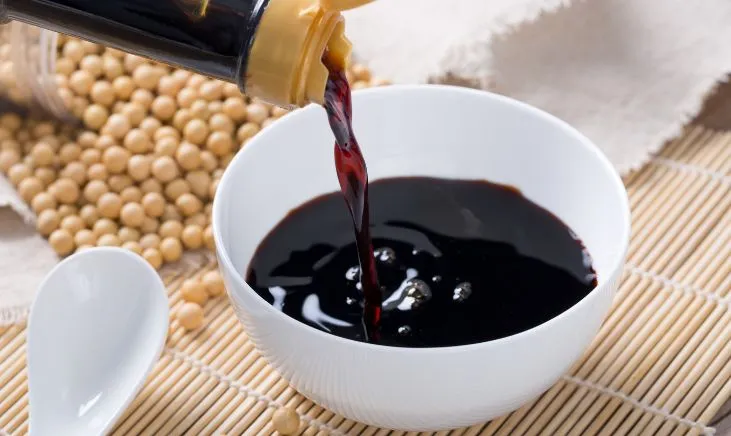The condiment aisle in the grocery store is packed with endless sauces, seasonings, and more. While many of the options are clearly very different, some may seem like they are pretty much the same thing, which may leave you confused and wondering how to pick the best one.
Liquid aminos, coconut aminos, and soy sauce are three very similar options with just a few key differences.
In this article, we break down what each of these is, how they are similar, and how they are different so you are able to choose which one is best for you.
Table of Contents
Short Summary
- Liquid aminos, coconut amino acids, and soy sauce are all salty, savory, umami sauces that can be used to add flavor to a variety of dishes.
- The main differences between these options include their ingredients, sodium content, and specific flavor profiles.

Liquid Aminos
Let’s dive into liquid aminos first.
What Are Liquid Aminos?
As their name suggests, liquid aminos are made from soybeans and contain concentrated amino acids.
If you’re not quite sure what amino acids are, they are the building blocks of protein. Liquid aminos contain 16 different essential amino acids and nonessential amino acids.
One of the most popular brands of liquid aminos are Bragg liquid aminos.
Nutrition Facts
One serving of liquid aminos is about one tablespoon. The nutrition facts for one tablespoon are:
- 15 calories
- 0 grams fat
- 0 grams protein
- 6 grams carbohydrates
- 960 milligrams of sodium
How Do You Use Liquid Aminos?
Liquid aminos look and taste similar to soy sauce and are often used as a substitute for soy sauce. They have a salty, savory, umami flavor, but they are generally less salty and more mild in flavor than soy sauce.
Liquid aminos can be used anywhere you would use soy sauce. One of the benefits of liquid aminos is that they are naturally vegan and gluten-free, making them a great option for anyone following either of those diets.

Coconut Aminos
Coconut amino acids are similar to liquid aminos with just a few differences. Let’s take a look at the specifics of coconut aminos.
What Are Coconut Aminos?
Coconut amino acids are similar to liquid aminos in that they are a liquid containing concentrated amino acids. The only real difference between the two is that coconut liquid aminos are derived from fermented coconut sap or nectar instead of soybeans.
Coconut amino acids contain 17 different essential amino acids and nonessential amino acids.
Bragg is a popular brand of coconut aminos in addition to Bragg liquid aminos.
Nutrition Facts
One serving of coconut aminos is about one tablespoon. The nutrition facts for one tablespoon are:
- 15 calories
- 0 grams fat
- 0 grams protein
- 6 grams carbohydrates
- 390 milligrams of sodium
How Do You Use Coconut Aminos?
Coconut aminos are another alternative to soy sauce. While this may seem counterintuitive, they don’t actually taste like coconut. They are salty and slightly sweet. Compared to soy sauce, they are milder in flavor and contain less sodium.
Coconut liquid aminos are also naturally vegan and gluten-free, as well as soy-free. They are also acceptable to consume on the paleo diet.

Soy Sauce
Soy sauce is really the original of these three sauces. Let’s look at its specifics.
What Is Soy Sauce?
As its name suggests, soy sauce is a sauce made by fermenting soybeans. Wheat, salt, and a fermenting agent are also used to make this salty sauce.
While it isn’t explicitly stated in its name as it is in the others, soy sauce does contain small quantities of multiple amino acids.
Nutrition Facts
One serving of soy sauce is about one tablespoon. The nutrition facts for one tablespoon are:
- 9 calories
- < 1 gram fat
- 1.3 grams protein
- < 1 gram carbohydrates
- 878 milligrams of sodium
How Do You Use Soy Sauce?
Soy sauce is used to add a salty, savory, umami flavor to food. It is most often used in Asian cuisine.
You can use soy sauce in:
- Stir-fry
- Soup
- Dipping sauce
- Salad dressings
- Marinades

Soy Sauce vs. Liquid Aminos
While the two are very similar, there are a few key differences between soy sauce and liquid aminos.
How Are They Similar?
Both soy sauce and liquid aminos are a liquid condiment made from soybeans. They also both contain the same 16 amino acids.
In terms of calories and macronutrients, these sauces are very similar, especially when considering the typical serving size.
How Are They Different?
The differences start in how they are made. Soy sauce is fermented, but liquid aminos are not.
Traditional soy sauce contains soy, wheat, and salt. While you can buy gluten-free soy sauce or tamari for a gluten-free and wheat-free option, and you can opt for low sodium soy sauce for an option with less sodium, liquid aminos are naturally gluten-free and lower in sodium than soy sauce.
When it comes to flavor, liquid aminos are slightly sweeter and milder than soy sauce, which has a more bold, savory, umami flavor.
Bottled soy sauce also often contains chemical preservatives. Another one of the benefits of liquid aminos is they do not. Additionally, soy sauce contains monosodium glutamate (MSG), while liquid aminos are MSG-free.
Finally, soy sauce is generally less expensive and more widely available compared to liquid aminos.

Liquid Aminos vs. Coconut Aminos
Again, these two sauces are very similar, but a few differences do exist.
How Are They Similar?
Both liquid aminos and coconut aminos are liquid sauces that contain the building blocks of proteins. They have similar calorie, fat, protein, and carbohydrate contents as well.
Liquid aminos and coconut aminos are both naturally gluten-free and vegan.
Both also have a mild, salty, but slightly sweet taste and can be used as a substitute for soy sauce.
How Are They Different?
The biggest difference is their origin. Liquid aminos are derived from soybeans whereas coconut liquid aminos are derived from fermenting coconut sap.
Liquids aminos are higher in sodium than coconut-based liquid aminos, with a sodium content more similar to soy sauce.

Summary: Liquid Amino Acids
To wrap it all up, liquid aminos, coconut amino acids, and soy sauce are very similar sauces that can be used to enhance the flavor of many foods.
They differ in their origin and ingredients, which may make one choice better for you, depending on the diet you follow. They also differ in their exact flavor profile so you may find you prefer the taste of one to the others.
Nutritionally, aside from their sodium content, they are very similar and can essentially be used interchangeably.
Whichever you choose, you can enjoy the benefit of the salty, savory flavor each sauce adds.

Frequently Asked Questions
What are the pros and cons of liquid aminos?
Liquid aminos provide a great deal of flavor to recipes and dishes without a lot of calories, fat, or carbohydrates. They are naturally vegan and gluten-free and make a great condiment choice for anyone following those specific diets.
The biggest con of soy-based liquid aminos is that while their name suggests they are full of amino acids, they are in fact very low in protein and contain very small quantities of amino acids in a normal serving size.
While they add great flavor, if you are looking for a boost of your amino acid intake, you are much better off looking for a different way to supplement amino acids.
Which is healthier: soy sauce or coconut aminos?
Soy sauce and coconut aminos are very similar in terms of their health benefits. Neither truly has more health benefits than the other, but depending on some personal factors, one may be a better choice for you.
If you have high blood pressure, coconut liquid aminos are a healthy substitute for soy sauce. Soy sauce is significantly higher in sodium, which contributes to high blood pressure.
If you follow a gluten-free diet or have a soy allergy, you will also need to choose coconut aminos, which are naturally gluten and soy-free. If you don’t have concerns about your blood pressure and do not need to avoid gluten or soy, soy sauce is a perfectly healthy option for you.
Why replace soy sauce with coconut aminos?
As we just discussed, coconut aminos are a great soy sauce replacement if you follow a gluten and/or soy-free diet. They are also a good alternative if you need to consume less sodium because you have high blood pressure or other health concerns.
Are coconut aminos stronger than soy sauce?
Coconut aminos generally have a milder flavor than soy sauce. Soy sauce has more salty, savory, and umami flavor, while coconut aminos are less salty and slightly sweeter.
Are liquid aminos good for weight loss?
Liquid aminos tend to be low in calories, but do not have any specific properties that make them good for weight loss. If you are aiming for a reduced calorie intake, liquid aminos can be a good sauce to use.
When comparing soy-based liquid aminos to coconut aminos and soy sauce, there are only marginal calorie and macronutrient differences which makes them essentially the same for weight loss.














